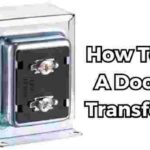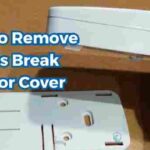Table of Contents
Are you wandering how many glass break sensors do I need? The exact number depends on the unique size and layout of your home.
I learned this lesson the hard way after a break-in at my own home. Despite having a security system, the burglars were able to smash a basement window undetected and steal thousands in valuables.
My family was shaken – I immediately realized our sensors were totally inadequate, only covering a few windows.
After replacing them with a professional-recommended setup, we finally regained peace of mind knowing every glass entry was protected.
In this comprehensive guide, we’ll cover everything you need to know to find the ideal setup for your home.
An Introduction to Glass Break Sensors
Before we dive into specifics, let’s start with an overview of how glass break sensors work and the key benefits they provide:
Glass break sensors (also called glass break detectors) are devices installed near windows and glass doors to detect the sound of breaking glass.
They contain microphones that can identify the unique frequencies produced when glass breaks.
This triggers an alarm and alert, warning you of a potential intruder entering your home.
These clever little sensors offer some great advantages as part of your home security system:
- Early detection – They recognize break-ins as soon as glass is shattered, minimizing damage and confrontation.
- Prevent false alarms – Advanced sensors can distinguish breaking glass from other loud sounds like slamming doors. This reduces costly false alarms.
- Flexible installation – Sensors can be wireless or wired into your security system for convenience.
- Peace of mind – There’s no replacement for the security and comfort provided by knowing your many windows and glass doors are protected.
Now let’s explore the key factors to consider when deciding how many glass break sensors you need.
Types of Glass Break Sensors
Before choosing quantities, it’s helpful to understand the two main sensor types available:
Acoustic Glass Break Sensors
Acoustic glass break sensors use built-in microphones to listen for the exact sound frequency profile of breaking glass.
This allows them to accurately distinguish glass shattering from other day-to-day sounds.
![[Image of acoustic glass break sensor device]](https://homeprotexs.com/wp-content/uploads/2023/11/Glass-Break-Sensor-1-1.jpg)
Advantages:
- Exceptional at detecting the unique sound of breaking glass
- Less prone to false alarms
- Wider and more reliable detection area
Limitations:
- More expensive than vibration sensors
- Can be affected by background noise
Vibration (Shock) Glass Break Sensors
Vibration glass break sensors use a piezoelectric transducer to detect the vibrations emitted when glass breaks. They are triggered by vibration patterns consistent with shattering glass.

Advantages:
- More affordable option
- Easy installation
Limitations:
- More likely to false alarm from vibrations of slamming doors or loud sounds
- Smaller detection radius than acoustic sensors
Now that you know the main sensor types available, let’s go over the key factors to consider when deciding how many you need.
Key Factors That Determine Sensor Quantity
Choosing the right number of glass break detectors involves carefully evaluating your home’s unique landscape.
The ideal setup balances cost, convenience and truly comprehensive protection. Key factors include:
- Size and layout of rooms
- Number of windows and glass entry points
- Vulnerability of certain areas
- Budget
Let’s explore each of these in more detail:
Size and Layout of Rooms
The number of sensors needed for full detection coverage varies by room size and configuration.
For medium to large rooms, a single centrally placed sensor may leave blind spots in distant corners or far walls. Multiple spread-out sensors ensure reliable protection.
Odd shaped rooms also often benefit from extra sensors to cover angular alcoves, bay windows and unusual nooks.
Small rooms may only require a single sensor within 10-20 feet of glass panes.
Get to know your home’s unique architecture and account for “problem spots” prone to evasion.
Number of Windows and Glass Entry Points
It almost goes without saying – the more glass windows and doors in a room, the more sensors you’ll need.
Prioritize protection for vulnerable ground floor windows and patio/deck doors which offer easy, tempting entry points for burglars.
Focus less on smaller second story windows which are more difficult to reach.
Sliding glass doors often benefit from a sensor directly overhead. For wide panes, position extra sensors at far sides for full coverage.
Vulnerability of Certain Areas
During placement, pay special attention to windows and doors in concealed, vulnerable spots. These high risk areas include:
- Ground floor windows hidden by landscaping or fencing
- Basement windows at ground level
- Doors and windows shielded from street view
- Side and rear windows covered by large trees, bushes or sheds
These secluded access points are inviting targets for burglars seeking discreet entry. Extra sensor coverage provides crucial protection.
Budget
Of course, budget plays a key role in sensor quantity decisions. Acoustic glass break detectors provide superior protection but cost more than twice as much as vibration sensors in most cases.
That said, security experts recommend not skimping when it comes to glass break sensors.
The peace of mind and enhanced safety they provide is well worth the investment for most homeowners.
Now that we’ve covered the key factors to weigh, let’s move on to specific installation best practices and sensor quantity recommendations.
Smart Sensor Placement for Optimal Protection
Strategic placement is just as important as the number of sensors you choose. Proper positioning ensures reliable detection and minimizes costly false alarms.
Follow these tips when installing your glass break sensors:
- Position sensors with a direct “line of sight” to glass panes within the detection radius. This allows sound and vibrations to reach them without obstruction.
- Avoid placing sensors directly behind furnishings or curtains that can block sound detection.
- Focus on securing vulnerable sliding doors, ground floor windows and secluded access points.
- Adjust sensitivity settings based on room background noise levels to reduce false alarms. Higher settings improve detection in quiet rooms.
- Test sensors regularly with a glass break simulator to ensure proper functionality.
- Consider professional installation for optimal positioning and configuration.
With smart placement and settings, you can maximize performance from each sensor.
How Many Glass Break Sensors Do I Need? Recommended Number of Sensors by Room
As a general guideline, security experts recommend placing at least one sensor in each room with glass windows or doors.
For average sized rooms, a single centrally located sensor typically provides sufficient coverage. Larger, elongated rooms and those with many panes will require multiple sensors.
Follow these room-by-room recommendations as a starting point when determining quantities:
Living Spaces
| Room | Recommended Sensors | Notes |
|---|---|---|
| Living room | 1-2 | Prioritize sliding glass door protection |
| Family room | 1-2 | Focus on any ground floor windows |
| Dining room | 1-2 | Cover patio/deck doors if present |
| Home office | 1 | Secure windows if ground floor located |
Bedrooms
| Room | Recommended Sensors | Notes |
|---|---|---|
| Master bedroom | 1 | Cover windows and bathroom if attached |
| Additional bedrooms | 1 | Secure any ground floor windows |
| Nursery | 1 | Position safely out of baby’s reach |
Kitchen
| Room | Recommended Sensors | Notes |
|---|---|---|
| Kitchen | 1 | Cover patio/deck doors if present |
| Breakfast nook | 1 | Protect bay windows if present |
Bathrooms
| Room | Recommended Sensors | Notes |
|---|---|---|
| Full bath | 1 | Cover any windows if present |
| Half bath | 0 | Sensors likely unnecessary |
Other Rooms
| Room | Recommended Sensors | Notes |
|---|---|---|
| Garage | 1 | Protect door leading into home |
| Laundry room | 1 | Cover external access door if exists |
| Finished basement | 1-2 | Secure any ground level windows |
| Attic | 0-1 | Optional for skylights or upper windows |
These figures serve as a helpful starting guide. Adjust quantities based on your floorplan and the risk factors covered earlier.
Reach out to a professional if needed to conduct a security assessment identifying ideal sensor placement and settings.
Acoustic vs. Vibration Sensors: Which is Better?
If debating between acoustic and vibration glass break sensor types, consider the following:
- Acoustic sensors provide more reliable protection but cost 2-3x more in most cases
- Vibration sensors are prone to more false alarms but offer a budget-friendly alternative
- Both options should meet needs for most homes when properly placed
- Professionals can advise the best option given room layout, background noise and glass types
Ideally, opt for acoustic sensors for rooms with minimal ambient noise like bedrooms and studies.
Use affordable vibration sensors in high traffic rooms like kitchens where false alarms are more likely.
Combining both sensor types provides the best of both worlds when budget allows!
Additional Tips for Maximizing Sensor Effectiveness
Beyond quantity and placement, a few additional best practices ensure your new sensors provide robust protection:
- Test sensors monthly using a glass break simulator to confirm functionality
- Clean sensors regularly to remove dust buildup that can impede detection
- Replace batteries annually or whenever you notice degraded performance
- Integrate sensors into a whole-home security system for centralized monitoring and control
- Pair sensors with external cameras to visually verify break-in attempts and speed emergency response
- Consider professional installation to perfectly tailor sensors to your homeʼs unique needs
- Update sensors as needed to take advantage of technology improvements and new innovations
How Many Sensors Do You Really Need?
As you can see, the ideal glass break sensor count depends on your home’s unique risk profile and layout.
While each room will typically need at least one, larger homes with many windows and doors may require 10 or more for air-tight security.
For a final personalized recommendation, contact a security professional to assess your residence and suggest optimal sensor types, quantities and placement.
DIY installation is possible, but expert configuration helps maximize protection and value from your investment.
FAQs
How High Should I Mount Glass Break Sensors?
The recommended mounting height for glass break sensors is 6-12 feet above the floor, positioned with an unobstructed line of sight to the window.
This allows the sensor to effectively detect the sound frequencies or vibrations emitted when glass breaks within its coverage radius.
Sensors mounted too low may have their detection impeded by furniture or room occupants. Excessively high placement reduces overall detection accuracy.
The optimal height depends on the type of sensor:
- Acoustic glass break sensors perform best mounted 8-12 feet high with a clear view of windows.
- Vibration sensors are typically mounted at 6-8 feet high and up to 15 feet away laterally from windows.
Also consider the window height itself – position the sensor above the top of the glass pane being protected. This straight-line coverage ensures the best monitoring capability.
Adjust specific mounting height based on room architecture and obstructions. Work with your installation professional to determine the ideal placement for maximum detection.
Can I Use Multiple Sensors For A Single Window?
Using multiple glass break sensors to monitor a single window is absolutely recommended for larger or elongated windows.
This provides complete edge-to-edge protection that a single centrally placed sensor may miss.
For picture windows, sliding doors and other expansive panes, position sensors at each far end for full coverage.
Overlapping detection ranges ensures reliable sensing if glass breaks at any point across the window’s width.
Large bay windows also benefit from extra corner-mounted sensors to eliminate blind spots in their uniquely angled design.
When installing multiple sensors for a single window:
- Space them evenly apart for ideal overlapping coverage
- Adjust sensitivity settings appropriately to avoid false alarm conflicts
- Combine acoustic and vibration sensors for comprehensive protection
Proper use of multiple sensors eliminates gaps in coverage and provides robust protection for exposed areas.
How Do I Test My Glass Break Sensors?
Testing your glass break sensors regularly is important to confirm they’re working properly and detect breaking glass reliably. Here are some recommended testing methods:
- Use a glass break sensor tester designed specifically for your model. This handheld device emits a simulated glass breaking sound to trigger the sensor.
- Tap a wine glass gently with a spoon to create a precise glass-shattering noise. Be sure to test softly to avoid actual breakage.
- Activate any built-in self-testing feature on your sensor by pressing the test button or following manufacturer instructions.
- For vibration sensors, gently strike the window to create a subtle vibration and mimic glass impact.
Ideally, test glass break sensors at least once per month to identify any issues early.
Pay attention that the control panel shows the expected triggered sensor and sounds an alarm. Also watch for any error messages or unusual delays in activation.
Testing ensures your sensors remain fully functional, your system communicates properly, and you enjoy maximum home protection.
Consider occasional professional testing for the most thorough analysis.
What Is The Battery Life Of Glass Break Sensors?
Glass break sensors are powered by small internal batteries that provide power for 1-2 years in most cases. Higher-end sensors may last closer to 5 years on a single battery.
Factors impacting battery lifespan include:
- Battery mAh rating (higher numbers indicate longer life)
- Power draw of signal transmissions to the control panel
- Frequency of sensor activations triggered by sounds
To maximize battery duration:
- Select name brand alkaline or lithium batteries over cheaper generics
- Enable battery-saving modes that minimize unnecessary signal transmission
- Clean sensors regularly to prevent excessive triggering from dust, spiders, etc.
Monitor your glass break sensor batteries by watching for signs of reduced performance like weaker signaling or limited detection range.
Proactively replace batteries once per year as a best practice.
Do I Need Glass Break Sensors On Every Window?
Installing glass break sensors on every window in your home provides maximum protection but may not be realistic or necessary for some spaces.
Focus sensors on accessible ground floor windows and doors first.
Prioritize sensor coverage for:
- Ground floor windows easily broken into
- Sliding glass doors which offer simple, tempting access
- Front/back entry doors with glass panes
- Basement windows at ground level
Bathrooms and second floor windows present much lower risk. Evaluate your home’s unique security risks first when allocating sensors.
Work outward from high priority windows as budget allows.
For cost efficiency, discuss vulnerable areas in your home with an installer first. Strategically position sensors at prime intrusion points rather than excessively blanketing every single pane.
What Is The Coverage Area Of The Glass Break Sensor?
The detection range of glass break sensors depends on the type:
Acoustic Sensors
- Can detect glass breaking from 15-25 feet away through walls and ceilings
- Environmental noises can reduce effective range
Vibration Sensors
- Detect glass vibrations reliably from 6-15 feet away
- Positioned directly on glass for best performance
- Nearby vibrations like footsteps reduce range
Larger rooms over 20 feet across may require multiple acoustic or vibration sensors positioned throughout for comprehensive monitoring.
Adjust sensor sensitivity settings to maximize coverage for a given room’s background noise and obstructions.
Work with your installer to properly calibrate and test detection range during initial configuration.
How Do I Know If My Glass Break Sensor Is Working?
To confirm your glass break sensor is working properly:
- Perform regular monthly tests using a glass break simulator, tapping a glass gently, or through built-in sensor self-tests.
- Watch for the control panel or mobile app to show the sensor activates when testing. Verify you receive the expected audible alarm.
- Make sure batteries are fresh and the sensor has no visible damage or debris buildup.
- Ensure LED status lights (if equipped) flash as expected, per the manufacturer guidelines.
- Confirm sensors show no trouble status or error messages through the security system interface.
- Verify detection range by testing sensors at varying distances and angles from windows.
- Consider hiring a professional to conduct in-depth sensor diagnostics if malfunctions persist.
With routine testing and status checks, you can confirm your glass break sensors are detecting properly and your family remains protected.
Don’t hesitate to replace sensors giving any indications of impaired performance.
Which Is Better Glass Break Sensor Or Motion Sensor?
Glass break sensors and motion sensors each serve unique purposes as part of a home security system.
Glass break sensors detect intruders breaking through windows and doors. Motion sensors identify movement inside your home.
Here’s how to decide which (or both) fit your security needs:
- Use glass break sensors to protect glass entry points and be alerted immediately when a window is broken.
- Install motion sensors to notice when an intruder moves through protected rooms beyond entry points.
- Glass break sensors act as the first line of defense for your home’s perimeter. Motion sensors provide an extra layer of protection inside.
- Combining both sensor types creates a comprehensive alert system guarding both the envelope of your home and interior spaces.
For the best protection, security professionals often recommend installing a glass break sensor in each room supplemented by motion sensors covering hallways, entries and other high-traffic areas.
This robust layered approach ensures maximum detection.
Conclusion
The bottom line is that Glass break sensors provide invaluable, cost-effective protection against smash-and-grab break-ins.
As essential elements of any home security system, they deliver peace of mind that your many glass entry points are secured.
While tempting, resist the urge to skimp on quantities. The enhanced safety and security offered by robust sensor coverage is well worth the investment for most homeowners.
Follow the guidelines above to choose the right number of sensors – and sleep easier at night knowing your home’s vulnerabilities are covered!




